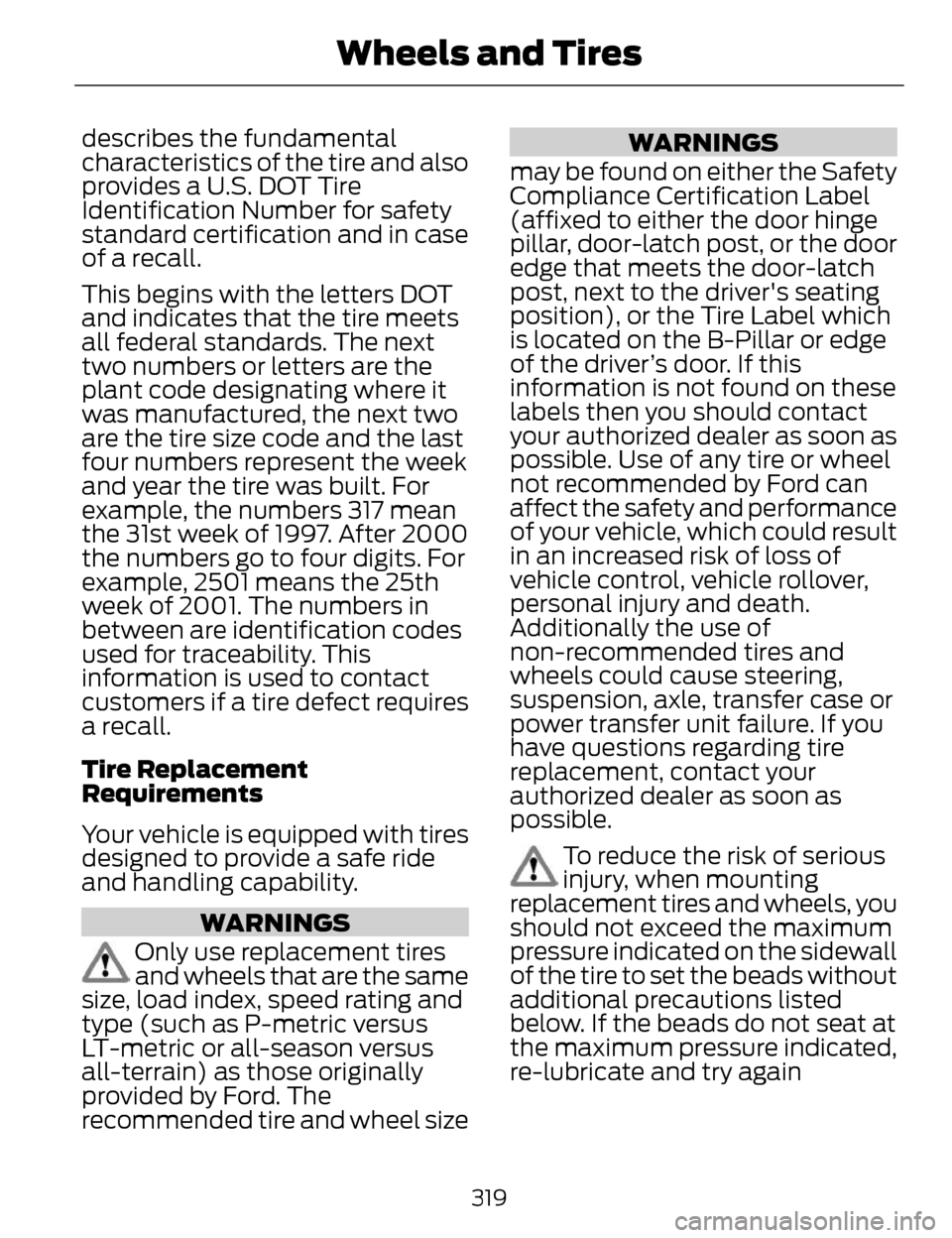2014 LINCOLN MKZ four wheel drive
[x] Cancel search: four wheel drivePage 322 of 468

describes the fundamental
characteristics of the tire and also
provides a U.S. DOT Tire
Identification Number for safety
standard certification and in case
of a recall.
This begins with the letters DOT
and indicates that the tire meets
all federal standards. The next
two numbers or letters are the
plant code designating where it
was manufactured, the next two
are the tire size code and the last
four numbers represent the week
and year the tire was built. For
example, the numbers 317 mean
the 31st week of 1997. After 2000
the numbers go to four digits. For
example, 2501 means the 25th
week of 2001. The numbers in
between are identification codes
used for traceability. This
information is used to contact
customers if a tire defect requires
a recall.
Tire Replacement
Requirements
Your vehicle is equipped with tires
designed to provide a safe ride
and handling capability.
WARNINGS
Only use replacement tires
and wheels that are the same
size, load index, speed rating and
type (such as P-metric versus
LT-metric or all-season versus
all-terrain) as those originally
provided by Ford. The
recommended tire and wheel size
WARNINGS
may be found on either the Safety
Compliance Certification Label
(affixed to either the door hinge
pillar, door-latch post, or the door
edge that meets the door-latch
post, next to the driver's seating
position), or the Tire Label which
is located on the B-Pillar or edge
of the driver’s door. If this
information is not found on these
labels then you should contact
your authorized dealer as soon as
possible. Use of any tire or wheel
not recommended by Ford can
affect the safety and performance
of your vehicle, which could result
in an increased risk of loss of
vehicle control, vehicle rollover,
personal injury and death.
Additionally the use of
non-recommended tires and
wheels could cause steering,
suspension, axle, transfer case or
power transfer unit failure. If you
have questions regarding tire
replacement, contact your
authorized dealer as soon as
possible.
To reduce the risk of serious
injury, when mounting
replacement tires and wheels, you
should not exceed the maximum
pressure indicated on the sidewall
of the tire to set the beads without
additional precautions listed
below. If the beads do not seat at
the maximum pressure indicated,
re-lubricate and try again
319
Wheels and Tires
Page 324 of 468

Driving habits have a great deal to
do with your tire mileage and
safety.
• Observe posted speed limits
• Avoid fast starts, stops andturns
• Avoid potholes and objects on the road
• Do not run over curbs or hit the tire against a curb when
parking
Highway Hazards
No matter how carefully you drive
there is always the possibility that
you may eventually have a flat tire
on the highway. Drive slowly to the
closest safe area out of traffic.
This may further damage the flat
tire, but your safety is more
important.
If you feel a sudden vibration or
ride disturbance while driving, or
you suspect your tire or vehicle
has been damaged, immediately
reduce your speed. Drive with
caution until you can safely pull
off the road. Stop and inspect the
tires for damage. If a tire is
under-inflated or damaged,
deflate it, remove the wheel and
replace it with your spare tire and
wheel (if provided). If you cannot
detect a cause, have the vehicle
towed to the nearest repair facility
or tire dealer to have the vehicle
inspected. Tire and Wheel Alignment
A bad jolt from hitting a curb or
pothole can cause the front end
of your vehicle to become
misaligned or cause damage to
your tires. If your vehicle seems to
pull to one side when you’re
driving, the wheels may be out of
alignment. Have an authorized
dealer check the wheel alignment
periodically.
Wheel misalignment in the front
or the rear can cause uneven and
rapid treadwear of your tires and
should be corrected by an
authorized dealer. Front-wheel
drive vehicles and those with an
independent rear suspension (if
equipped) may require alignment
of all four wheels.
The tires should also be balanced
periodically. An unbalanced tire
and wheel assembly may result in
irregular tire wear.
Tire Rotation
Note:
If your tires show uneven
wear ask an authorized dealer to
check for and correct any wheel
misalignment, tire imbalance or
mechanical problem involved
before tire rotation.
321
Wheels and Tires
Page 465 of 468

Temporary Mobility Kit.....................297First Stage: Reinflating the Tire withSealing Compound and Air.............299
General Information...............................298
Second Stage: Checking Tire Pressure...................................................301
Tips for Use of the Kit............................298
What to do after the Tire has been Sealed.....................................................302
What to do when a Tire Is Punctured..............................................299
The Better Business Bureau (BBB)Auto Line Program (U.S.
Only)....................................................250
Tire Care.................................................307
Glossary of Tire Terminology..............309
Information About Uniform Tire
Quality Grading...................................308
Information Contained on the Tire Sidewall...................................................310
Temperature A B C.................................309
Traction AA A B C....................................308
Treadwear..................................................308
Tire Inflation When PuncturedSee: Temporary Mobility Kit.................297
Tire Pressure Monitoring System................................................303
Changing Tires With a Tire Pressure
Monitoring System.............................305
Understanding Your Tire Pressure Monitoring System ............................305
Tire Repair KitSee: Temporary Mobility Kit.................297
TiresSee: Wheels and Tires............................297
Towing a Trailer...................................232Load Placement.......................................232
Towing the Vehicle on FourWheels.................................................237
Emergency Towing..................................237
Recreational Towing...............................237
Towing....................................................232 Traction Control...................................184
Principle of Operation............................184
Transmission Code
Designation........................................332
Transmission.........................................167
Transmission
See: Transmission.....................................167
Transporting the Vehicle.................236
U
Under Hood Overview - 2.0L EcoBoost™........................................269
Under Hood Overview - 3.7L..........270
Universal Garage Door Opener..................................................143
HomeLink Wireless Control
System.....................................................143
Using Adaptive Cruise Control.......199Blocked Sensor........................................204
Changing the Set Speed.......................203
Detection Issues......................................203
Disengaging the System.......................202
Following a Vehicle................................200
Hilly Condition Usage.............................203
Low Speed AutomaticCancellation..........................................203
Overriding the System...........................202
Resuming the Set Speed......................203
Setting a Speed.......................................200
Setting the Gap Distance......................201
Switching the System Off....................203
Switching the System On.....................199
Switching to Normal Cruise Control....................................................205
System Not Available............................204
Using All-Wheel Drive........................173Driving In Special Conditions With All-Wheel Drive (AWD)......................174
Using Cruise Control..........................198Switching Cruise Control Off...............199
Switching Cruise Control On................198
462
Index